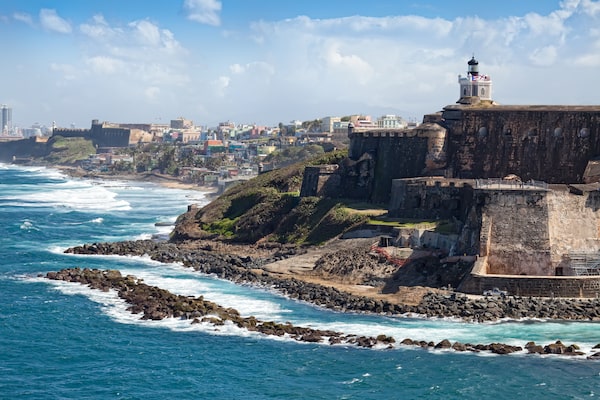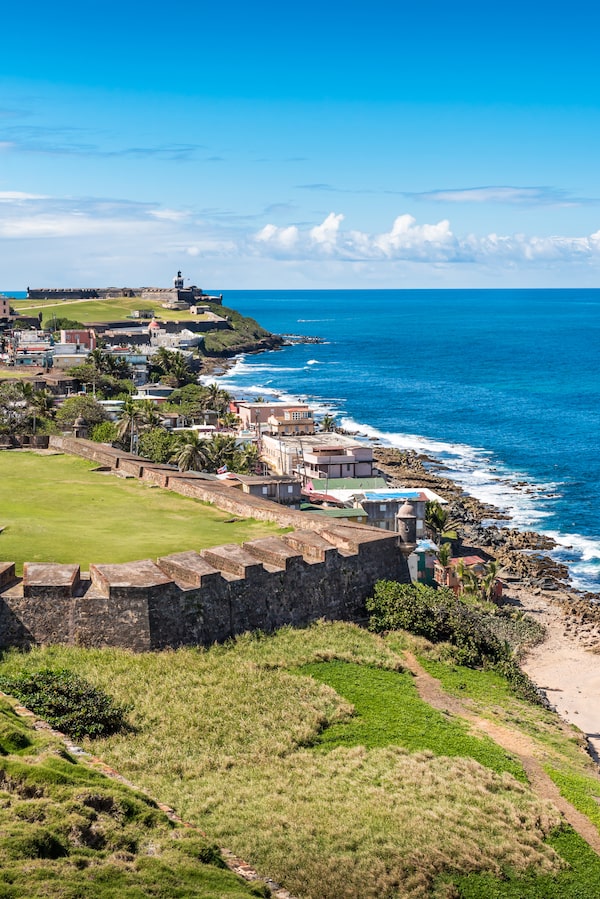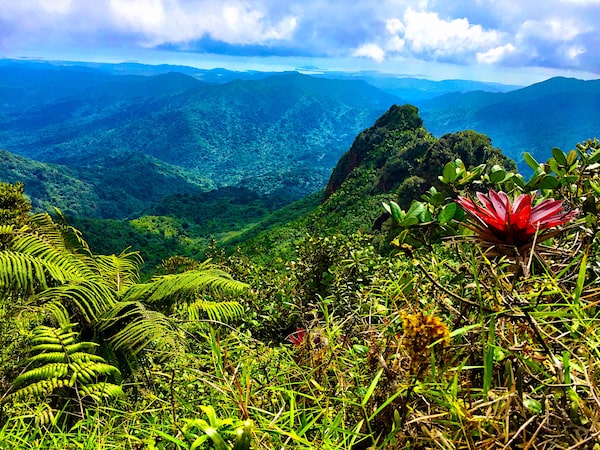
El Morro. Built by Spanish colonists in the 1590s, this stone fortress helped keep Puerto Rico under Spanish control for more than 400 years.fallbrook
Seen off our starboard bow of the Amazing Grace, a 33-foot schooner, nothing about Old San Juan suggests it was recently hit by a hurricane. The city looks pretty much as it did last summer, which is pretty much the way it’s looked for centuries – a terraced jumble of bright pastel walls and cobblestone streets capped with a skyline of flat roofs and cathedral spires. Laundry hangs between balconies. Shoppers mill along narrow sidewalks. A startled loft of pigeons scatters up from an alley. From behind us, the setting tropical sun bathes the whole scene in faded neon light.
When Hurricane Maria made landfall here in September, 2017, it plunged the island into a months-long electrical blackout and, at the latest count, contributed to the deaths of nearly 3,000 people. The storm crippled the U.S. commonwealth’s already struggling infrastructure and some of that damage has yet to be repaired. But tourists are coming back; and for most of them, particularly those visiting Old San Juan, last year’s destruction is out of both sight and mind.
It is certainly far from the thoughts of my fellow passengers on this sunset pleasure cruise, which departs daily from the Old San Juan pier. Their focus is on our captain, Hiram, who points out the city’s highlights. Sandwiched between two larger buildings is La Casa Estrecha, a nine-foot row home widely considered the narrowest house in the world. Further down the hill is La Fortaleza, the governor’s mansion. Just along the water are barracks for the U.S. Coast Guard. Then, towering above cliffs at the mouth of San Juan Bay, the stern façade of El Morro. Built by Spanish colonists in the 1590s, this stone fortress helped keep Puerto Rico under Spanish control for more than 400 years. Paired with cannons from a smaller fort across the bay, El Morro generated a crossfire fierce enough to repel the French, English and Dutch navies. It finally fell in 1898, when the U.S. seized Puerto Rico as a colony of its own.

The view of the ocean from Castillo de San Cristobal towards San Felipe del Morro.Shutterdo
Our ship plays into the island’s maritime history: It’s a near-perfect replica of those used by privateers in the 18th century. It looks just like every pirate ship in the movies – with modern modifications, of course (and a four-person crew who ensures no one onboard goes too long without a drink in hand). It is understandably a tourist darling, and even now is usually sold out days in advance.
My fellow passengers, mostly from the mainland United States, tell me their vacations have been wholly unaffected by Hurricane Maria. Anthony and Jayne, from Manhattan, have lounged undisturbed on the beach by the Hotel Intercontinental. Bleary-eyed Shyla and Rebecca danced all night between the open-air bars of Placita Santurce. Chris and Sami seem happy just to have sidestepped an awkward family reunion. None of them have experienced so much as a flicker in their lights.
Elsewhere, cruise lines have resumed traffic to the pier and the city’s streets bustle with vendors selling fried pork, piraguas (basically tropical snow cones) and pirate-themed souvenirs. Shops are open. Restrooms have running water. At least around the island’s main cruise ship port, things seem to be back to normal.

Piragua in Old San Juan, Puerto Rico. Piraguas are basically tropical snow cones.alexandra oquendo
As for the rest of the island? That depends whom you ask.
Brad Dean, chief executive of Discover Puerto Rico, the island’s destination marketing agency, will tell you this: “Puerto Rico is not just recovering. The island is coming back bigger and better than ever.”
He’s got the numbers to back it up. The island currently has around 10,000 working hotel rooms, he said, with at least 4,000 more expected to be refurbished by the end of the year. About 110 flights from 28 airlines are flying in daily and 1,885 restaurants are open. With US$1.9 billion in tourism development projects in the works, he described the island as poised for an international travel renaissance.
“We are not only back in business,” he said, “but eager to welcome visitors back. We have recovered.”
On the ground, though, observant travellers will find recovery is still in the works. While power is back virtually everywhere, many hotels on the eastern coast are still in need of renovations. Zipline tours and other attractions operate around the El Yunque rainforest, but most of the jungle itself is closed for fear of landslides. Homes everywhere still rely on government-issue tarps for roofs. In the urban centres, street art and graffiti give voice to a growing anti-U.S. sentiment. “El desastre es el colonialismo,” reads one common tag. “The disaster is colonialism.”
“The island is still beautiful, but it’s not as perfect as everyone is painting it,” said Damaris Garcia, a manager for East Island Excursions, the company that owns Amazing Grace. “They say, ‘Come here, have some pina coladas! Everything’s perfect! Everything’s fine!’ And it is still beautiful, but it’s also sucky.”

The El Yunque rainforest.Carson Albanese
Garcia tells me her business has remained steady in the season after Maria, but that the type of her clientele has changed. In place of hedonists drawn by the island’s beaches and nightclubs, she now encounters a hardier breed of conscious travellers. Frustrated and embarrassed by U.S. President Donald Trump’s response to the disaster, these tourists wield their vacation dollars as a form of aid.
They are likely to find these dollars well spent: Puerto Rico remains a premier tropical destination. Its climate is unparalleled and its beaches are still among the best in the world. For culture lovers, the island’s churches, museums and beachside food shacks offer an open window into life in the Spanish Caribbean.
“The people are here with open arms and smiling faces,” Grace said. “We’re still here and we’re still open. Just come. And stay local.”
What to know
When to go: Peak tourism season is generally between mid-December and early April. Weather remains friendly though May, but summer rains and the Atlantic hurricane season are reason enough to avoid trips from June to November.
Getting there: WestJet plans to resume weekly direct flights from Toronto to San Juan on Oct. 29. They’ll offer twice-weekly flights from Dec. 9-April 27. Air Canada plans to resume regular service to Puerto Rico some time this winter.

The view of the Old San Juan cityscape and beach.Domini Clark
Getting around: Taxis and Uber are available in San Juan, but travellers hoping to see other parts of the island should consider renting a car. Many of the island’s highways are toll roads, but you can pay for these upfront through your rental car company. Canadian drivers licenses are accepted.
Finding lodging: Though most of the island’s hotels have reopened after Hurricane Maria, travellers should still call to confirm reservations. Locally owned options are often available through AirBnb and VRBO.
Speaking: About 30 per cent of Puerto Rican residents speak English, so travellers should be able to navigate the island without mastery of the Spanish language. Basic Spanish will be extremely helpful in rural areas, though, and will be appreciated everywhere.
Where to go
For beaches: Top-quality beaches are available all across the island, but the very best are on the north and west coasts. This author’s favorites are Playa Escambron in San Juan, Survival Beach in Aguadilla and Playa Sucia in Cabo Rojo.
For art and culture: The walled city of Old San Juan is a must see – be sure to check out the green meadow by El Morro and the cemetery below. World-class art museums can be found in both San Juan and the southern city of Ponce.
For adventure: Though much of the El Yunque rainforest is still closed to hikers, several zipline operators offer tours from nearby Luquillo. For a still stronger spike of adrenalin, consider a cave tour from San Juan’s Aventuras Tierra Adentro.
For bragging rights: To get off the beaten path, consider taking a flight or ferry to Puerto Rico’s two outer islands, Vieques and Culebra. Both have a wild and rugged quality, with world-class snorkelling and crowd-free beaches. But be warned – both islands work at a relaxed pace, so services can be slow.